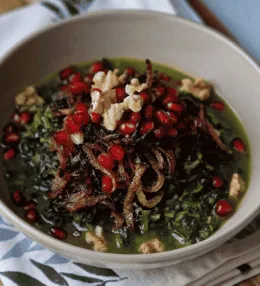
- View
Table of Contents
TogglePinakbet is one of the most loved vegetable dishes in the Philippines, known for its rustic flavours and strong connection to home cooking. It is a colourful stew that brings together the produce of the land with a deeply savoury note.
Served in households and roadside eateries, it is a dish that feels simple yet carries a great deal of meaning. Pinakbet celebrates the taste of vegetables without masking them, making it a meal that feels both hearty and honest.
This is not food that chases glamour. It is a dish that quietly delivers comfort with every spoonful. It draws out the best of fresh vegetables by pairing them with the distinctive taste of fermented fish or shrimp paste.
Want to dive deeper into Filipino Cuisine? Don’t miss our post on 28 Traditional Filipino Foods to Try
What Is Pinakbet
Pinakbet is a traditional Filipino vegetable stew that is slow cooked to allow flavours to meld without losing the character of each ingredient. It is a dish built around local vegetables, a touch of protein and a rich seasoning base.
The vegetables are cut into bite sized pieces and added to a pot where they are gently simmered. The result is a mixture that keeps its texture while absorbing the savoury flavour that defines this much loved dish.
Pinakbet is usually served as a main part of the meal with rice. It can be found from coastal towns to mountain provinces, as every region adapts it slightly to what grows well in their soil and what is easily available.
Ingredients and Taste
Typical vegetables for Pinakbet include aubergine, okra, bitter gourd, string beans and squash. The vegetables are stewed with garlic, onion and tomato, creating a base that is aromatic and naturally sweet.
A small amount of bagoong, a fermented fish or shrimp paste, is added to give the dish its unique savoury depth. Some versions add pork or seafood, but the focus remains firmly on the vegetables themselves.
The taste is a mix of earthy, slightly sweet and pleasantly salty flavours. Bitter gourd adds a touch of sharpness while squash softens the dish with a gentle sweetness. It is a balanced and satisfying combination.
A Taste of History
Pinakbet traces its roots to the Ilocos region in the north of the Philippines. It was born out of the farming culture where simple ingredients from the fields were turned into meals that could feed a family.
The dish takes its name from a local word meaning shrunken or shrivelled, describing how the vegetables reduce during slow cooking. It is a reflection of resourcefulness, making the most out of what the land offers.
Over time Pinakbet spread across the islands and developed slight variations. The heart of the dish remains the same wherever it is cooked, celebrating the union of vegetables, fermented seasoning and patient cooking.
Today Pinakbet is both everyday fare and a dish that appears in gatherings. It connects people to the soil and traditions of the Philippines, showing how a simple pot of vegetables can carry history and a sense of place.
How to Make Pinakbet (Vegetable Stew)
Pinakbet is a classic Filipino vegetable stew from the Ilocos region, celebrated for its medley of native vegetables simmered with shrimp paste. Expect a savoury, earthy dish with a slight sweetness from pumpkin and an umami depth from bagoong. This slow simmered dish rewards patience and balance of flavours. See the recipe card at the bottom for printable directions
Ingredients
For the stew
- 2 tbsp oil (traditionally groundnut or coconut oil)
- 2 medium tomatoes, chopped
- 1 medium onion, sliced
- 2 garlic cloves, finely chopped
- 150 g pork belly, cut into small strips
- 1 tbsp fermented shrimp paste (bagoong alamang)
- 200 g pumpkin or squash, peeled and cut into cubes
- 200 g aubergine, sliced into thick rounds
- 100 g okra, trimmed
- 150 g yardlong beans (sitaw), cut into 5 cm lengths
- 100 g bitter melon (ampalaya), sliced and deseeded
- 100 g baby corn or native corn, cut into chunks
- 250 ml water
For seasoning
- 1 tbsp fish sauce (patis)
- Freshly ground black pepper to taste
Cooking Instructions
Step 1: Prepare the vegetables
To begin, wash and cut all vegetables into uniform pieces. Keeping them similar in size helps them cook evenly. Move on to preparing the pork.
Step 2: Render the pork fat
In a wide pan, heat the oil over medium heat. Add pork belly and cook gently until it releases its fat and turns lightly golden. Transition to building the flavour base.
Step 3: Build the aromatics
Add garlic, onion, and tomatoes to the pan. Sauté until the tomatoes soften and the mixture becomes fragrant. Stir well to prevent sticking. Move to seasoning with shrimp paste.
Step 4: Add the shrimp paste
Stir in the bagoong alamang. Allow it to fry gently for a minute so the sharpness mellows and the flavour deepens. Next, incorporate the vegetables starting with the firmest.
Step 5: Add the pumpkin and water
Place the pumpkin pieces in the pan and pour in the water. Cover and simmer for 5 minutes to allow the pumpkin to begin softening. Proceed with adding the remaining vegetables.
Step 6: Layer the remaining vegetables
Add aubergine, okra, yardlong beans, bitter melon, and baby corn on top of the pumpkin. Do not stir at this point. Cover the pan and steam the vegetables gently for 10 minutes.
Step 7: Season the stew
Remove the lid, drizzle in fish sauce, and sprinkle a little ground pepper. Gently mix the vegetables, taking care not to mash the pumpkin. Transition to final simmering.
Step 8: Simmer to finish
Let the stew cook uncovered for another 5–7 minutes until the vegetables are tender but still vibrant. Adjust seasoning if needed. Move to the plating step.
Final step: Serve hot
Serve Pinakbet in a deep bowl with steamed rice. Garnish with a few drops of extra fish sauce or a spoonful of bagoong on the side. For authenticity, serve family style to share.
Variations and substitutions
- Substitute pork belly with small pieces of fried tofu for a vegetarian version.
- If bagoong alamang is unavailable, use Thai shrimp paste or anchovy paste sparingly.
- Use green beans in place of yardlong beans, and courgettes for aubergine if not accessible.
- Sweet potato can replace pumpkin for a slightly different sweetness.
Cooking Tips for Perfect Pinakbet
- Use a wide shallow pan to keep the vegetables in a single layer for even cooking.
- Avoid over stirring to maintain the shape of tender vegetables.
- Allow the shrimp paste to cook before adding water for a more rounded flavour.
- Slight bitterness from ampalaya balances the richness; do not omit it if possible.

Pinakbet (Filipino Vegetable Stew)
Ingredients
For the stew
- 2 tbsp oil traditionally groundnut or coconut oil
- 2 medium tomatoes chopped
- 1 medium onion sliced
- 2 garlic cloves finely chopped
- 150 g pork belly cut into small strips
- 1 tbsp fermented shrimp paste bagoong alamang
- 200 g pumpkin or squash peeled and cut into cubes
- 200 g aubergine sliced into thick rounds
- 100 g okra trimmed
- 150 g yardlong beans sitaw, cut into 5 cm lengths
- 100 g bitter melon ampalaya, sliced and deseeded
- 100 g baby corn or native corn cut into chunks
- 250 ml water
For seasoning
- 1 tbsp fish sauce patis
- Freshly ground black pepper to taste
Instructions
- To begin, wash and cut all vegetables into uniform pieces. Keeping them similar in size helps them cook evenly. Move on to preparing the pork.
- In a wide pan, heat the oil over medium heat. Add pork belly and cook gently until it releases its fat and turns lightly golden. Transition to building the flavour base.
- Add garlic, onion, and tomatoes to the pan. Sauté until the tomatoes soften and the mixture becomes fragrant. Stir well to prevent sticking. Move to seasoning with shrimp paste.
- Stir in the bagoong alamang. Allow it to fry gently for a minute so the sharpness mellows and the flavour deepens. Next, incorporate the vegetables starting with the firmest.
- Place the pumpkin pieces in the pan and pour in the water. Cover and simmer for 5 minutes to allow the pumpkin to begin softening. Proceed with adding the remaining vegetables.
- Add aubergine, okra, yardlong beans, bitter melon, and baby corn on top of the pumpkin. Do not stir at this point. Cover the pan and steam the vegetables gently for 10 minutes.
- Remove the lid, drizzle in fish sauce, and sprinkle a little ground pepper. Gently mix the vegetables, taking care not to mash the pumpkin. Transition to final simmering.
- Let the stew cook uncovered for another 5–7 minutes until the vegetables are tender but still vibrant. Adjust seasoning if needed. Move to the plating step.
- Serve Pinakbet in a deep bowl with steamed rice. Garnish with a few drops of extra fish sauce or a spoonful of bagoong on the side. For authenticity, serve family style to share.
Nutrition
You May Also Like







Leave a Review